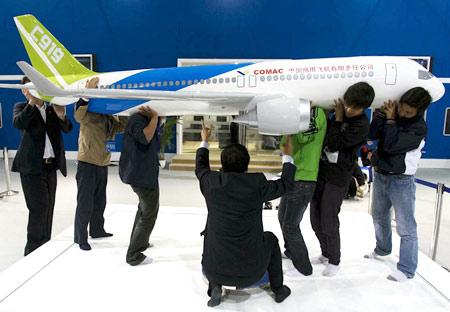
Commercial Aircraft Corporation of China employees adjust a C919 airplane model at the 2009 China International Industry Fair held last November in Shanghai. The nation started work on an aircraft engine research and development center yesterday. [China Daily]
Yesterday's ground breaking of an aircraft engine R&D center in Shanghai may help the city in its bid to become the nation's aircraft-manufacturing hub.
The ceremony, located in the city's Minhang district, was held by AVIC Commercial Aircraft Engine Company Co (ACAE), a joint venture with the Aviation Industry Corp of China (AVIC).
AVIC develops and manufactures military aircraft and components for both military and civilian aircraft.
The R&D facility will serve as a center for air-worthiness testing, customer service and international communications. In addition, it will serve as the headquarters for ACAE.
Total investment in the R&D center will be 3.23 billion yuan, with construction to be completed by 2013, according to ACAE general manager Zhang Jian.
The center will focus on engine research and manufacturing for China's home-grown, 150-seat aircraft project, the C919. Future plans will also include researching larger jet engines.
The Shanghai municipal government and AVIC reached a strategic cooperation agreement in November 2008 to co-invest in ACAE and help make Shanghai into a manufacturing center for Chinese development of passenger-aircraft engines.
China's first jumbo jet, the C919, will initially be equipped with foreign-made engines for the plane's maiden flight in 2014.
ACAE will domestically produce C919 engines once it masters the necessary techniques.
According to Zhang, the first homegrown engine is expected to come off the assembly line in 2016.
The engine, which makes up 20 percent of an aircraft's total cost, and is traditionally regarded as the heart of an airplane. So far, China has not developed its own engines, which has stifled its growth in the aviation industry.
Last December, Commercial Aircraft Corp of China Ltd (COMAC), the company in charge of the C919 passenger airplane program, signed a deal with CFM International, a joint venture between General Electric and Safran of France. Under the agreement, the C919 will be equipped with Leap-X1C turbofan engines.
On the same day, ACAE reached an agreement with CFM International to co-fund the assembly line and testing center for the Leap-X1C engine.
In early January, ACAE signed a memorandum of understanding with its German counterpart, MTU Aero Engine, to research and develop China-made engines, but details on specific areas of cooperation have yet to be disclosed.
China's process of building its own aircraft and engines will be extremely difficult and time consuming, especially with existing passenger-jet makers working to improve efficiency while lowering costs, said Li Gangling, an analyst at Industrial Securities.
"But it's a must-do for the Chinese aviation industry. As we all know, it takes a lot of time and money to acquire aircraft from Western countries. Yet you cannot fully develop your aviation industry if you cannot master the technique of aircraft-engine manufacturing," Li added.
Currently four countries, the US, the UK, France and Russia, are capable of making their own aircraft engines.
China's effort to be the world's fifth nation to make large aircraft engines will help reduce its reliance on foreign jet suppliers, such as Boeing and Airbus, analysts said.





